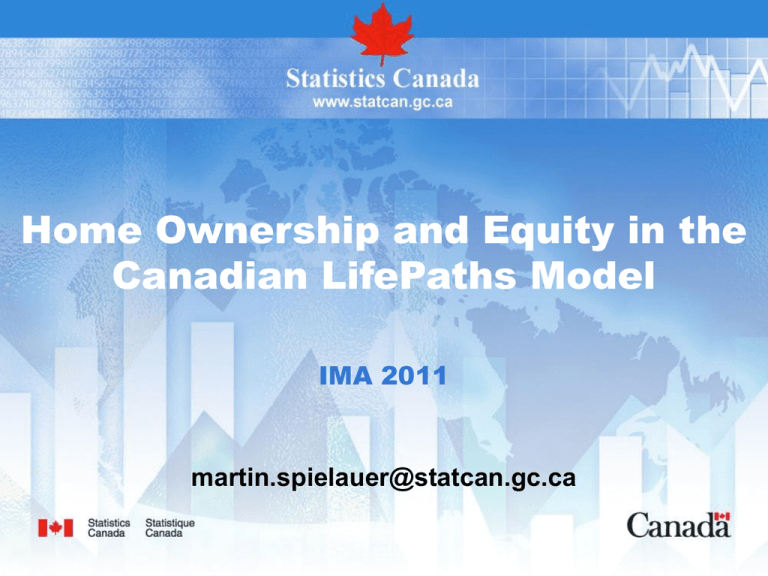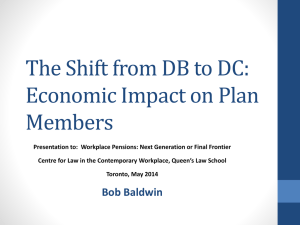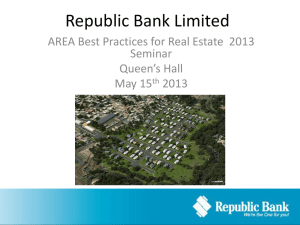Slide - martin @ spielauer . ca
advertisement

Home Ownership and Equity in the Canadian LifePaths Model IMA 2011 martin.spielauer@statcan.gc.ca Organization: What? • What is LifePaths? Why? • Home ownership in context of model applications • Home ownership in context of development strategy How? • Data • Assumptions • Parameterization • Implementation Results & Outlook What is LifePaths? Large dynamic multi-purpose Canadian model, developed and maintained at Statistics Canada Programmed in the generic microsimulation programming language Modgen Continuous time model Case based model Open population Synthetic starting population Historic depth: first actors born 1871 Home ownership in the context of model applications For study of retirement income adequacy For a majority home equity is single largest investment: potential source of retirement income. The study of retirement income adequacy compares lifecourse pre- and post-retirement consumption. Typically: • Consumption reduced due to housing investments / mortgage payments in younger ages • Housing equity a potential additional source of income in retirement Home ownership in the context of the LifePaths development strategy Currently, saving behaviors in LifePaths are limited to registered pension savings (Deferred Income Plans) • Registered Pension Plans linked to employment (RPPs) • Private Registered Retirement Saving Plans (RRSPs) Housing wealth is a first step in more complete implementation of lifetime saving and consumption. Mortgage loans part of an integrated accounting system on a personal and family level. Data sources Single most important data source are census data 1971 - 06 The “long –form” (a 20% sample) contains information on • Home ownership & dwelling characteristics, e.g. value • Individual and household characteristics, e.g. income Missing in census: • Finance / Equity: • Savings: Complementary data sources Survey for Financial Security used for modeling finance (Ontario) Tax data linking property value, income, pension savings; used for study of correlation Various other data sources, e.g. mortgage interest rates Data: Home ownership rates Very stable ownership rates by age over cohorts Plateau reached at 65 0.80 0.70 0.60 0.50 Immigrants: later start, but fast catch-up Families have higher ownership rates at all incomes 0.40 0.30 0.20 0.10 20 to 24 25 to 29 30 to 34 35 to 39 40 to 44 45 to 49 50 to 54 55 to 59 60 to 64 65 to 69 70 to 74 75+ Age Birth cohorts 1916 to 1920 1921 to 1925 1926 to 1930 1931 to 1935 1936 to 1940 1941 to 1945 1946 to 1950 1951 to 1955 1956 to 1960 1961 to 1965 1966 to 1970 1971 to 1975 1976 to 1980 Source: Feng Hou: Homeownership over the Life Course of Canadians: Evidence from Canadian Censuses of Population Data: Correlation with pension savings Almost no correlation of ownership rates with annual registered retirement savings Distribution of property values mostly depends on • Single/couple status • Income For given income, home value is positively correlated with annual registered pension savings Pension contributions 2005 Source: Ontario tax data, Couples Model assumptions People stay in ownership, except in case of union dissolution No correlation with pension savings Ownership rates depend on age, 5% income quantile, and household type Property values depend on • Calendar time • Household type • Income (5% quantile) • Position in home value distribution (5% quantile) The position in home value distribution is randomly assigned and fix over life Parameterization: ownership 5% Income Quantiles: by calendar year and HH type. Produced by LP simulation Ownership rates: by age, household type, income quantile. 2006 census Home purchase probabilities: by HH type, income quantile and age. Calculated from a simulated source-destination matrix and ownership benchmarks Ownership rates by age and income quantile; couples 100.00% 90.00% 80.00% 70.00% 60.00% 50.00% 40.00% 30.00% 20.00% 10.00% 0.00% 18 20 22 24 26 28 30 32 34 36 38 40 42 44 46 48 50 52 54 56 58 60 62 64 Parameterization: value and finance Home value quantile means for each income quantile: by household type, calendar year (Census, scenarios) Mortgage interest rate (CANSIM, scenarios) Distribution of initial down-payments as proportion of home value: by HH type and age at purchase. 5% steps (SFS) For further purchases (e.g. at union formation), the equity of the previous property is used as down payment. First and second mortgage: • A first mortgage is assumed to have 25 years duration • The second mortgage is used to finance upgrades in home value and has a 10 year duration Parameterization: up/downsizing, other Share of home value changes assumed to be down/up-sizing: • House price index controlled for quality improvement (proxy CPI) • Yearly home value changes in the range of +/-5% from the general house price index are ignored • 50% of remaining changes are financed via 2nd mortgage / cashed out (and used to pay back mortgage depths if applicable) Imputed rent: 3.5% of home equity Algorithm Step 1: Make mortgage payments if applicable Step 2: Decide if a home is sold (due to union events) Step 3: Decision if a home is purchased. Those who sold a home at union formation immediately buy a new home Step 4: Assign or update a home value Step 5: Finance the home • Down payment • Mortgage 1: 25 years • Mortgage 2: with each increase reset to 10 years Validation Ownership rates and home values by age, household type and income consistent with Census data by construction Probably too high fluctuation of property values caused by income fluctuations Equity in property by age: good fit with Survey of Financial Security (SFS) data LifePaths 2005 SFS 2005 Equity by age, couples Illustration of Results: replacement rates after retirement Stacked average replacement rates by component and retirement cohort, 1966-2060 120% 110% Replacement rate (%) 100% 90% 80% Housing equity 70% RRSP RPP 60% GIS/SPA 50% C/QPP 40% OAS 30% 20% 10% 0% 1966- 1971- 1976- 1981- 1986- 1991- 1996- 2001- 2006- 2011- 2016- 2021- 2026- 2031- 2036- 2041- 2046- 2051- 20561970 1975 1980 1985 1990 1995 2000 2005 2010 2015 2020 2025 2030 2035 2040 2045 2050 2055 2060 (Year an individual turns 66) Source: Kevin D. Moore, William Robson, Alexandre Laurin (2010) Canada’s Looming Retirement Challenge; C.D. Howe Institute Commentary Pension Papers Summary and Outlook Inclusion of housing closes a gap in the analysis of retirement income adequacy, but is only a first step towards a complete model of savings Planned improvements of housing module • Modeling on provincial level • Better integration into continuous time framework • More detailed response to life course events: migration, immigration, union dissolution, death of partner • Modeling of sales / downsizing in retirement Accounting framework including other assets • Consistency: budget constraints • Inheritance and intergenerational transfers








